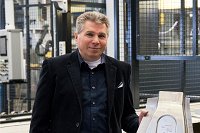AP&T: “New lightweight solutions can increase the range of electric cars”
08.03.2018
AP&T, which develops production solutions for the car industry with focus on weight, safety and energy efficiency, believes that new opportunities for the design and manufacture of lighter car components can give the next generation of electric cars the range needed for a true breakthrough.
Reducing vehicle weight has been a priority for the world’s car manufacturers for a long time, since lower weight results in lower gasoline or diesel consumption and thus also lower emissions of climate-damaging carbon dioxide.
Replacing conventionally manufactured body parts with parts made of press-hardened steel, which is both strong and lightweight, has proven to be a relatively easy way to reduce weight without compromising safety. Most manufacturers today already have the first wave of weight-savings measures under their belt. However, efforts to reduce weight continue at the same rate that emissions standards are becoming more stringent, which means that designers of the next generation of cars are faced with new challenges.
 AP&T has been developing production solutions for press hardening since the beginning of the 2000s, and is currently one of the dominant players in the market. The company is responsible for over a fifth of all press hardening lines installed for car manufacturers and component suppliers around the world.
AP&T has been developing production solutions for press hardening since the beginning of the 2000s, and is currently one of the dominant players in the market. The company is responsible for over a fifth of all press hardening lines installed for car manufacturers and component suppliers around the world.
“The press hardening solutions we are currently developing are much more sophisticated and provide completely different opportunities than previously. By using advanced press control, each part can obtain the exact qualities required. For example, soft zones can be added to a part,” says AP&T Director Business Development and Marketing Per Josefsson.
For the next major step aimed at weight savings, however, replacing a part with a corresponding one made out of a different material will not suffice. According to Per Josefsson, a broader overall perspective on material selection, manufacturing method and design is needed to achieve an optimal solution. AP&T calls this a holistic approach.
“We can take a regular B-pillar as an example. Many manufacturers today use B-pillars made out of press-hardened steel. Instead of replacing the material in that part alone, it might be better to choose an entirely different design. The entire car door ring could be manufactured in one piece out of high-strength aluminum, for example, which combines high strength with much lower weight than steel can offer. Doing so would provide a rational production process and major weight savings.”
In autumn 2017, AP&T presented the world’s first production line for manufacturing complex-shaped car components out of high-strength aluminum specifically. The innovation has received a great deal of international attention, and has received both the Altair Enlighten Award and the SIQ Quality Innovation Award.
The new possibilities to design and manufacture components out of lighter and stronger materials enable a new wave of weight savings, which can subsequently greatly boost the development of electric cars.
“The driving forces for continuing to reduce weight are strong regardless of the propulsion system, but the most exciting development is in electric cars. More lightweight solutions in cars mean fewer batteries are needed to achieve greater range, which is precisely in line with market demands and what is needed to speed up the transition to a more sustainable transportation sector,” says Per Josefsson.













































